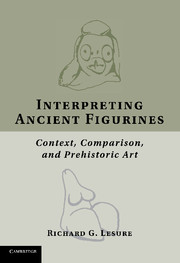Book contents
- Frontmatter
- Contents
- Figures and Tables
- Acknowledgments
- Introduction
- One Universalist Explanation and Prehistoric Figurines
- Two Comparison and Context
- Three The Questions We Ask of Images
- Four A Cross-Cultural Explanation for Female Figurines?
- Five Mesoamerican Figurines and the Contextualist Appeal to Universal Truths
- Six Figurines, Goddesses, and the Texture of Long-Term Structures in the Near East
- Seven On Figurines, Femaleness, and Comparison
- Notes
- Bibliography
- Index
Seven - On Figurines, Femaleness, and Comparison
Published online by Cambridge University Press: 01 March 2011
- Frontmatter
- Contents
- Figures and Tables
- Acknowledgments
- Introduction
- One Universalist Explanation and Prehistoric Figurines
- Two Comparison and Context
- Three The Questions We Ask of Images
- Four A Cross-Cultural Explanation for Female Figurines?
- Five Mesoamerican Figurines and the Contextualist Appeal to Universal Truths
- Six Figurines, Goddesses, and the Texture of Long-Term Structures in the Near East
- Seven On Figurines, Femaleness, and Comparison
- Notes
- Bibliography
- Index
Summary
When we ponder what to say about prehistoric figurines, our path toward interpretation starts with observable characteristics of the objects. The question I have been pursuing is: When characteristics in one context resemble characteristics in another, should that comparative observation play a role in our interpretation and, if so, what role?
Because our interpretation is to be social in content, at some point we need to shift any perceptions of material similarity to the social terms in which our conclusions will be framed. Figurine analysts tend to reformulate quickly from the material to the social. At an early stage in the analysis, they choose basic postulates concerning the social implications of figurines. That move sharply delimits the field of possible final social interpretations. Although narrowing the field of interpretations is the entire point of analysis, it proves difficult – based on material observations – to justify one set of social terms over another. With the figurines providing no clear guidance, evidence tends to be overwhelmed by theory. These kinds of problems are pervasive in archaeology, but they are particularly tenacious when the topic of study is expressive material culture.
One result can be interpretations so impervious to falsification that material patterns simply do not matter. It is easy, in retrospect, to chortle over a traditional analytical framework that took “an emphasis on sexual characteristics and disregard for appendages” to be evidence that figurines belonged “to the Mother-goddess cult” but that blithely assigned figurines with arms and no sexual characteristics to the same cult.
- Type
- Chapter
- Information
- Interpreting Ancient FigurinesContext, Comparison, and Prehistoric Art, pp. 207 - 218Publisher: Cambridge University PressPrint publication year: 2011



